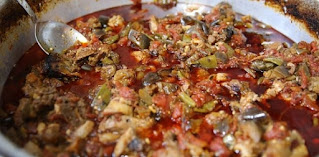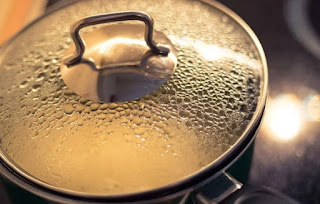7 Methods Of Cooking Food Without Losing its Nutrients
 |
| Photo credit: Pixabay.com |
Some Food needs to be cooked before it can be consumed. The same food can be prepared by different methods for consumption. However, Each method can give a different appearance, texture, and taste. Whichever way food is cooked, the most important thing is that its nutrients are still retained.
In this article, we shall discuss 7 different methods of cooking food without losing its nutrients. This guide will explain one after the other methods that can be used to prepare food.
Things to be discussed in this article:
• Different Methods of cooking
• Points to consider in choosing a cooking method
The 7 methods of cooking food without losing its nutrients are;
• Stewing
• Boiling
• Steaming
• Baking
• Frying
• Roasting
• Grilling
1. STEWING
 |
| Food Stewing Photo credit: Pixabay.com |
Cooking food slowly or at low heat in a small quantity of water is called Stewing. Stewing is commonly used for making soup. It is done by covering a pot for a long time with low heat. One of the major reasons for Stewing is softening tough meat and other tough cooking ingredients.
Advantages of Stewing:
1. Stewing Retained foods nutrients in the Stewing water/liquid.
2. The food's flavors are retained.
3. Stewed food is easily digested.
4. It helps to soften tough ingredients easily.
Disadvantages of Stewing
1. It is a time-consuming method of cooking.
2. Cooking gas wastage because it takes a long time to cook.
2. BOILING
Boiling is another method of cooking food without losing its nutrients. Boiling involves the process of cooking food in boiling water until it is tender. Yam, Rice, Beans, and Plantain are examples of food that can be boiled.
Guidelines For Boiling:
• Ensure that water covers the food to be cooked.
• Lid should fit the pot to avoid loss of steam and heat.
• Don't overcook the food.
• For some food like Yam and Potatoes, Strain the water after boiling.
Advantages of Boiling:
1. It is the most suitable method of cooking.
2. It makes food soft and easy to digest.
3. It is the quickest method of cooking.
4. Many foods can be cooked by Boiling.
The disadvantage of boiling:
1. You must stay with the food while cooking to avoid burning.
3. STEAMING
Steaming is the method of cooking using the steam of boiling water. Steaming can be done using the machine or by using vapor directly from the pot. Food like Egg, Meat, Fish, etc. Can be steamed.
Guidelines for Steaming:
• The lid should fit tightly
• Water in the container to be used must be boiling.
• Foods to be steamed should be wrapped with nylon to prevent the food from becoming sodden.
• Replenish the water as it boils away.
• Time of cooking will depend on the type of food being cooked.
Advantages of Steaming:
1. Steaming is suitable to make children's food because steamed food is easily digested.
2. Nutrients are retained in the food steamed.
3. It is easy to cook food through streaming.
Disadvantages of streaming:
1. Steaming consumes fuel/gas because it takes a longer time to cook food.
2. Food steamed lacks flavor.
3. Steamed food requires seasoning.
4. FRYING
Frying is the method of cooking that involves cooking food in hot oil. Many foods can be cooked by frying. Examples of food that can be fried are; Meat, Yam, Plantain, and Fish. Frying also helps to retain food nutrients.
Guidelines for frying
• Choose the best type of frying suitable for the food to be fried. For instance, Shallow Frying is for eggs while deep frying is for beans cake.
• Use quality oil to fry the food.
• Do not cover the pot/pan while frying
• Drain water completely from food before frying it.
• Ensure that the oil is hot enough before frying.
• Turn the food only when necessary.
Types of Frying:
There are 4 types of frying and they are;
1. Shallow Frying: Meat, Pancakes, and fish are examples of food cooked by shallow frying. It requires that you put a little amount of oil in the pan just to cover the bottom of the pan.
2. Deep Fat Frying: Plenty of oil is required to fry the food here. Doughnut, chin-chin, and Yam slices are examples of food by Deep fat frying.
3. Sauteing: This is the act of tossing food in a small amount of oil.
4. Dry Frying: Dry Frying is the act of frying food in its oil. Bacon is a good example of food cooked by Dry frying.
Advantages of Frying:
1. Fried food is tasty
2. Fried food does not lose its flavor
3. Frying is a quick method of cooking.
Disadvantages of Frying:
1. It requires constant attention.
2. Not easily digested.
5. ROASTING
Roasting is the method of cooking food either in an open fire, heated sand or ash, heated charcoal, and in an enclosed space.
Yam, cocoyam, Plantain, and potato are examples of food that can be cooked by roasting.
Advantages of Roasting:
1. It gives a good flavor to food
2. It is easy.
3. It is a fast method of cooking.
Disadvantages of Roasting:
1. Roasting usually shrink food.
2. It requires constant and full attention.
6. BAKING
 |
| Baking Photo credit: Pixabay.com |
Baking is the method of cooking that involves using heated air. Air is heated up to the required temperature in an enclosed space like oven. The heated air cooks the food.
Bread, cake, pudding, and Biscuits are examples of food cooked by baking.
Guidelines for baking:
• Clean the oven thoroughly.
• Grease baking pan.
• Avoid frequent opening of the oven. You can time your cooking.
• Monitor your cooking to avoid burning.
Advantages of Baking:
1. Food baked are usually well cooked.
2. It helps to retain food nutrients.
Disadvantages of Baking:
1. It requires a lot of attention
2. It requires temperature control
7. GRILLING
Grilling is a method of cooking that involves placing raw food over, under, or in front of a smokeless fire. Grilling is another good way of retaining food's nutrients.
Bacon, Corn, and Yam are good examples of food that can be grilled.
Advantages of Grilling:
1. Grilled food can digest easily.
2. It is a good method of retaining food's nutrients.
3. Grilling is a quick method of cooking.
Disadvantages of Grilling:
1. It is time-consuming
2. It requires attention
Points to consider in choosing a cooking method
Before choosing any out of these 7 methods of cooking, the following points should be considered.
1. Type of food to be cooked: You need to understand that various food requires different methods of cooking. Food to be cooked will determine which method will be used in cooking such food.
2. Loss of Nutrients: Some foods can loos it's nutrients in the process of cooking. For instance, vitamins in the food can be lost if food is boiled and the cooking water is discarded.
3. Who will eat the food: Children and elderly people need food that can be easily digested. Therefore, steaming can be considered the best method in this category.
4. Time Available: Some cooking method takes a longer time. To determine which method to use, the time available to make such food needs to be considered.
Conclusion:
Cooking and eating food is not just enough. We must ensure that the foods we eat contain nutrients that will help our body in one way or the other.




